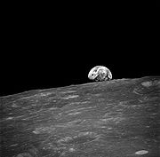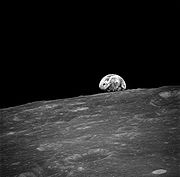
Lunar orbit
Encyclopedia

Astronomy
Astronomy is a natural science that deals with the study of celestial objects and phenomena that originate outside the atmosphere of Earth...
, lunar orbit (also known as a Selenocentric orbit) refers to the orbit
Planetary orbit
In physics, an orbit is the gravitationally curved path of an object around a point in space, for example the orbit of a planet around the center of a star system, such as the Solar System...
of an object around the Moon
Moon
The Moon is Earth's only known natural satellite,There are a number of near-Earth asteroids including 3753 Cruithne that are co-orbital with Earth: their orbits bring them close to Earth for periods of time but then alter in the long term . These are quasi-satellites and not true moons. For more...
.
As used in the space program, this refers not to the orbit of the Moon about the Earth
Earth
Earth is the third planet from the Sun, and the densest and fifth-largest of the eight planets in the Solar System. It is also the largest of the Solar System's four terrestrial planets...
, but to orbits by various manned or unmanned spacecraft around the Moon. The altitude at apoapsis (point farthest from the surface) for a lunar orbit is known as apolune (or apocynthion), while the periapsis (point closest to the surface) is known as perilune (or pericynthion).
Unmanned spacecraft
The Soviet UnionSoviet Union
The Soviet Union , officially the Union of Soviet Socialist Republics , was a constitutionally socialist state that existed in Eurasia between 1922 and 1991....
sent the first spacecraft to the vicinity of the Moon, the unmanned vehicle Luna 1
Luna 1
Luna 1 , first known as First Cosmic Ship, then known as Mechta was the first spacecraft to reach the vicinity of the Moon and the first of the Luna program of Soviet automatic interplanetary stations successfully launched in the direction of the Moon.While traveling through the outer Van Allen...
, on January 4, 1959. It passed within 6000 km (3,239.7 nmi; 3,728.2 mi) of the Moon's surface, but did not achieve lunar orbit. Luna 3
Luna 3
The Soviet space probe Luna 3 of 1959 was the third space probe to be sent to the neighborhood of the Moon, and this mission was an early feat in the spaceborne exploration of outer space...
, launched on October 4, 1959, was the first unmanned spacecraft to complete a cislunar flight, still not a lunar orbit, but a figure-8 free return trajectory
Free return trajectory
A free return trajectory is one of a very small sub-class of trajectories in which the trajectory of a satellite traveling away from a primary body is modified by the presence of a secondary body causing the satellite to return to the primary body...
which swung around the far side of the Moon
Far side of the Moon
The far side of the Moon is the lunar hemisphere that is permanently turned away, and is not visible from the surface of the Earth. The far hemisphere was first photographed by the Soviet Luna 3 probe in 1959, and was first directly observed by human eyes when the Apollo 8 mission orbited the Moon...
and returned to the Earth. This craft provided the first pictures of the far side of the Lunar surface.
The Soviet Luna 10
Luna 10
Luna 10 was a Luna program, robotic spacecraft mission, also called Lunik 10.The Luna 10 spacecraft was launched towards the Moon from an Earth orbiting platform on March 31, 1966. It was the first artificial satellite of the Moon...
became the first spacecraft to actually orbit the Moon
Moon
The Moon is Earth's only known natural satellite,There are a number of near-Earth asteroids including 3753 Cruithne that are co-orbital with Earth: their orbits bring them close to Earth for periods of time but then alter in the long term . These are quasi-satellites and not true moons. For more...
in April 1966. It studied micrometeoroid
Micrometeoroid
A micrometeoroid is a tiny meteoroid; a small particle of rock in space, usually weighing less than a gram. A micrometeor or micrometeorite is such a particle that enters the Earth's atmosphere or falls to Earth.-Scientific interest:...
flux, and lunar environment until May 30, 1966.
The first United States
United States
The United States of America is a federal constitutional republic comprising fifty states and a federal district...
spacecraft to orbit the Moon was Lunar Orbiter 1
Lunar Orbiter 1
The Lunar Orbiter 1 robotic spacecraft, part of the Lunar Orbiter Program, was designed primarily to photograph smooth areas of the lunar surface for selection and verification of safe landing sites for the Surveyor and Apollo missions...
on August 14, 1966. The first orbit was an elliptical orbit, with an apolune of 1008 nmi (1,866.8 km; 1,160 mi) and a perilune of 102.1 nmi (189.1 km; 117.5 mi). Then the orbit was circularized at around 170 nmi (314.8 km; 195.6 mi) to obtain suitable imagery. Five such spacecraft were launched over a period of thirteen months, all of which successfully mapped the Moon, primarily for the purpose of finding suitable Apollo program landing sites.
See also Lunar mission#US orbital missions (2009)-
Manned spacecraft
The Apollo program's Command/Service ModuleApollo Command/Service Module
The Command/Service Module was one of two spacecraft, along with the Lunar Module, used for the United States Apollo program which landed astronauts on the Moon. It was built for NASA by North American Aviation...
(CSM) remained in a lunar parking orbit while the Lunar Module
Apollo Lunar Module
The Apollo Lunar Module was the lander portion of the Apollo spacecraft built for the US Apollo program by Grumman to carry a crew of two from lunar orbit to the surface and back...
(LM) landed.
The combined CSM/LM would first enter an elliptical orbit, nominally 170 nmi (314.8 km; 195.6 mi) by 60 nmi (111.1 km; 69 mi), which was then changed to a circular parking orbit of about 60 nmi (111.1 km; 69 mi). Orbital periods vary according to the sum of apoapsis and periapsis, and for the CSM were about two hours. The LM began its landing sequence with a descent orbit with a perilune of about 50000 ft (15.2 km; 8.2 nmi), chosen to avoid hitting lunar mountains reaching heights of 20000 ft (6.1 km; 3.3 nmi).
Perturbation effects
Gravitational anomalies slightly distorting the orbits of the Lunar Orbiters led to the discovery of mass concentrations (dubbed mascons), beneath the lunar surface caused by large impacting bodies at some remote time in the past. These anomalies are significant enough to cause a lunar orbit to change significantly over the course of several days.The Apollo 11
Apollo 11
In early 1969, Bill Anders accepted a job with the National Space Council effective in August 1969 and announced his retirement as an astronaut. At that point Ken Mattingly was moved from the support crew into parallel training with Anders as backup Command Module Pilot in case Apollo 11 was...
first manned landing mission employed the first attempt to correct for this effect. The parking orbit was "circularized" at 66 nmi (122.2 km; 76 mi) by 54 nmi (100 km; 62.1 mi), which was expected to become the nominal circular 60 nmi (111.1 km; 69 mi) when the LM made its return rendezvous
Space rendezvous
A space rendezvous is an orbital maneuver during which two spacecraft, one of which is often a space station, arrive at the same orbit and approach to a very close distance . Rendezvous requires a precise match of the orbital velocities of the two spacecraft, allowing them to remain at a constant...
with the CSM. But the effect was overestimated by a factor of two; at rendezvous the orbit was calculated to be 63.2 nmi (117 km; 72.7 mi) by 56.8 nmi (105.2 km; 65.4 mi).

